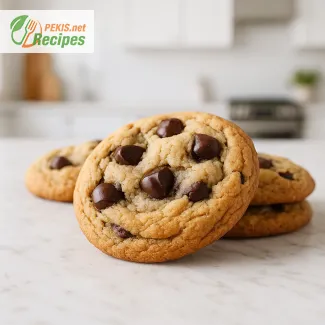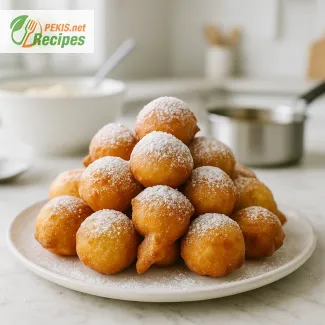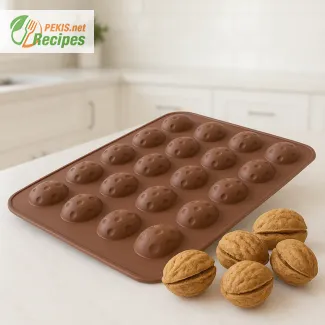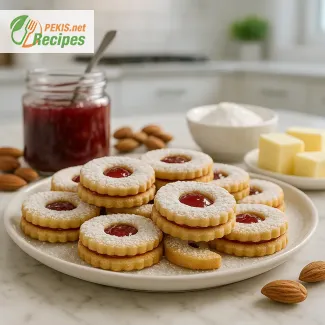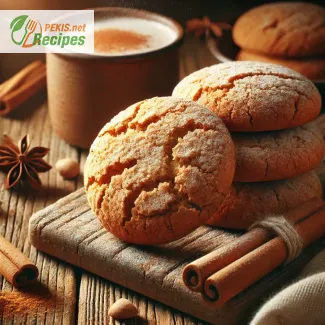
When the days grow shorter and the winter air is crisp with the scent of pine, few things evoke warmth and comfort quite like a batch of homemade cinnamon cookies fresh out of the oven. These delightful cookies combine the rich, earthy flavors of cinnamon, butter, and a hint of vanilla, creating an unforgettable treat that is ideal for winter gatherings, holiday celebrations, or simply a cozy evening at home with a hot cup of tea or cocoa.
The Charm of Homemade Cinnamon Cookies
What makes these cinnamon cookies so irresistible? It's not only the crisp, golden exterior but also the soft, melt-in-your-mouth center that bursts with cinnamon's distinctive warmth. This balance of textures – crisp edges giving way to a tender center – is what elevates these cookies from the ordinary to the extraordinary. The subtle sweetness and aromatic spice of cinnamon brings depth to every bite, perfectly capturing the essence of winter. Whether they're enjoyed on their own or paired with a glass of milk, these cookies are destined to become a favorite seasonal treat.
Preparation: Creating a Treat That Feels Like Home
Homemade cinnamon cookies are simple to prepare yet incredibly rewarding. The dough comes together quickly, allowing you to enjoy the scent of cinnamon and vanilla in no time. For those seeking a deeper, nuttier flavor, consider incorporating a touch of brown sugar into the dough, which also lends a slight caramel undertone. Baking these cookies fills the kitchen with a fragrance that is both nostalgic and inviting – a scent that tells you something delicious is in the making.
For a perfectly shaped batch, chill the dough for about an hour before rolling and cutting it. This extra step enhances the flavor and ensures that the cookies keep their shape as they bake, yielding picture-perfect results every time.
Ideal for Gifting and Sharing
Homemade cinnamon cookies make wonderful gifts, especially during the holiday season. Their long shelf-life allows you to prepare them in advance and package them beautifully in festive boxes or jars. These cookies are sturdy enough to survive shipping or a few days of travel, making them an ideal gift for family and friends far and wide. Wrapped in rustic parchment paper and tied with a ribbon, they carry a touch of love and care, reminding the recipient of warm, wintery memories.
How Far in Advance Can You Prepare Them?
Cinnamon cookies are a fantastic make-ahead dessert. You can prepare the dough up to three days in advance and keep it refrigerated, allowing the flavors to develop even further. Alternatively, the dough can be frozen for up to three months, so you can simply defrost, bake, and enjoy them whenever the craving strikes. After baking, the cookies themselves will stay fresh for about a week when stored properly, making them a convenient choice for holiday preparation.
Serving Suggestions for Maximum Enjoyment
For a touch of indulgence, serve these cookies with a dusting of powdered sugar or drizzle them with a vanilla glaze. Their warm flavor pairs exceptionally well with drinks like mulled wine, spiced cider, or a frothy pumpkin latte. If you want to go the extra mile, try serving them with a side of cinnamon whipped cream or vanilla ice cream for a dessert that feels luxurious yet comforting.
Storage Tips for Freshness
To keep your homemade cinnamon cookies fresh and flavorful, store them in an airtight container at room temperature. They should remain deliciously crisp for up to a week. For extended storage, consider freezing them; they hold up well in the freezer for up to two months. Just place a layer of parchment paper between each cookie to prevent them from sticking together, and store them in a freezer-safe container or bag. When you're ready to enjoy them again, simply let them thaw at room temperature, and they'll taste just as good as the day they were baked.
The Magic of Cinnamon in Winter
Cinnamon is more than just a spice; it’s a key ingredient that evokes a sense of warmth and nostalgia, especially in winter. Known for its antioxidant and anti-inflammatory properties, cinnamon can also provide a subtle health boost, adding an extra layer of goodness to these delicious cookies. It’s this spice’s ability to bring warmth, comfort, and a touch of winter magic that makes cinnamon cookies so fitting for the season.
Homemade cinnamon cookies truly are the perfect winter dessert. Their cozy aroma, delightful texture, and heartwarming flavor make them a staple for chilly days and festive gatherings alike. Every bite is a reminder of the simple joys of winter, filling your home and heart with the unmistakable warmth of the season.
Homemade Cinnamon Cookies – The Perfect Winter Dessert
This recipe for Homemade Cinnamon Cookies is designed to bring warmth and comfort during the winter season. These cinnamon-infused treats offer a delightful crunch with a tender center, making them a family favorite for holiday gatherings or cozy evenings at home.
Step 1: Prepare the Dough
- Cream the Butter and Sugars: In a large mixing bowl, combine 115 g butter, 100 g granulated sugar, and 50 g brown sugar. Cream the ingredients together on medium speed until the mixture is light and fluffy, about 2–3 minutes.
- Add Wet Ingredients: Add 1 large egg and 5 ml vanilla extract to the mixture. Beat on medium speed until fully incorporated and smooth.
Step 2: Combine Dry Ingredients
- Sift and Mix Dry Ingredients: In a separate bowl, sift together 220 g all-purpose flour, 5 g baking powder, 1 g salt, and 10 g ground cinnamon. Add the ground nutmeg (1 g) if desired for an extra layer of warmth and flavor.
- Incorporate Dry Ingredients: Gradually add the dry ingredients to the butter mixture, mixing on low speed until the dough comes together. Be careful not to overmix, as this can make the cookies tough.
Step 3: Chill the Dough (Optional but Recommended)
- Chill the Dough: For best results, cover the bowl with plastic wrap and refrigerate the dough for about 30 minutes. This helps the cookies hold their shape and intensifies the cinnamon flavor.
Step 4: Shape and Bake
- Preheat the Oven: Preheat your oven to 180°C (350°F).
- Shape the Cookies: Scoop out 1 ½ tablespoon-sized balls of dough and roll them between your palms to form a smooth, round shape. Place them on a baking sheet lined with parchment paper, leaving about 5 cm (2 inches) between each cookie to allow for spreading.
- Bake: Place the baking sheet in the oven and bake for 10–12 minutes, or until the edges are golden but the centers are still soft.
- Cool: Remove the cookies from the oven and allow them to cool on the baking sheet for a few minutes. Then, transfer them to a wire rack to cool completely.
Step 5: Serving and Storing
- Serve: These cookies are best enjoyed warm, but they can be stored at room temperature in an airtight container for up to a week.
- Storage Tips: For extended storage, freeze the baked cookies in an airtight container for up to two months.
These Homemade Cinnamon Cookies capture the essence of winter with their warm spice and tender bite, making them an ideal dessert for any chilly day. Enjoy their subtle sweetness alongside a hot beverage, and let them become part of your cozy, seasonal memories!
The Impact of Nutritional Values and Ingredients in Homemade Cinnamon Cookies on Health
Homemade Cinnamon Cookies, while often associated with warmth and indulgence, offer several health aspects through their ingredients, even in a treat-based context. Each ingredient brings specific nutrients, vitamins, and minerals that contribute to our body’s overall functioning, particularly when enjoyed in moderation as part of a balanced diet. These cookies provide a balance of carbohydrates, fats, and minimal proteins alongside trace amounts of essential vitamins and minerals. Let’s dive into how each component affects the body and why mindful consumption can make this winter treat both enjoyable and part of a well-rounded diet.
Key Ingredients and Their Health Benefits
1. Butter
Butter, a traditional source of fat, plays a dual role in cookies by adding flavor and texture. While high in saturated fats, it also provides vitamins A, D, E, and K.
- Vitamin A: Important for vision, immune function, and cellular communication. Vitamin A from butter is primarily in the form of retinol, which is easily absorbed and utilized by the body.
- Vitamin D: Essential for bone health and immune function. Although the amount in butter is minimal, every contribution helps during winter months when sunlight exposure is reduced.
- Vitamin E: An antioxidant that protects cell membranes from oxidative damage and supports skin health.
- Vitamin K: Plays a role in blood clotting and bone health.
2. Sugar (Granulated and Brown Sugar)
Sugars in these cookies are a primary source of quick energy for the body, delivering carbohydrates that are easily broken down into glucose. While sugar is calorie-dense and lacking in vitamins or minerals, it provides immediate energy. The brown sugar adds a small amount of minerals such as calcium, potassium, iron, and magnesium, though in trace amounts.
- Potassium: Helps regulate fluid balance, muscle contractions, and nerve signals.
- Calcium and Magnesium: Both are essential for bone health and muscle function.
3. Eggs
Eggs are a valuable ingredient, providing a mix of proteins, fats, and an impressive nutrient profile:
- Proteins: Essential for muscle repair and growth, with eggs being a complete protein source containing all nine essential amino acids.
- Vitamin B12: Crucial for nerve health and red blood cell formation. It’s particularly beneficial during colder months when energy levels might feel low.
- Vitamin D: Eggs offer a small but valuable source of vitamin D, supporting bone health and immune function.
- Iron: Essential for the formation of hemoglobin and helps maintain energy levels. The iron in eggs is in the heme form, which is more readily absorbed by the body.
4. All-Purpose Flour
Flour is the main source of carbohydrates in cookies, providing energy. While standard all-purpose flour is lower in nutrient density than whole grains, it does contribute to the daily carbohydrate intake.
- Fortified flour may contain added iron and folic acid (B9), supporting red blood cell production and cellular health.
- For a boost in fiber and other vitamins like B vitamins, whole-grain flour could be substituted for all-purpose flour, which would provide additional health benefits.
5. Cinnamon
Cinnamon, beyond its aromatic and warming qualities, has notable health benefits, particularly through its bioactive compounds:
- Antioxidants: Cinnamon contains powerful antioxidants that help combat oxidative stress in the body, which is essential for cellular health and aging.
- Anti-inflammatory properties: Cinnamon’s compounds, such as cinnamaldehyde, support immune function and may reduce inflammation.
- Blood sugar regulation: Cinnamon has been studied for its potential role in stabilizing blood sugar levels, which is beneficial for people managing insulin sensitivity or type 2 diabetes.
6. Vanilla Extract
While vanilla is used in small amounts, it contains antioxidants and trace minerals such as manganese.
- Antioxidants: Help protect cells from damage caused by free radicals.
- Manganese: Supports bone health, metabolism, and wound healing.
Nutritional Considerations and Impact on Health
The nutritional profile of these cookies, as seen per serving, reflects a balance of macronutrients – primarily carbohydrates and fats – with modest amounts of protein. Although the calorie count per cookie is relatively low (around 90 kcal), the sugar content is moderate and contributes to the overall carbohydrate intake. High sugar consumption, if not balanced within a diet, can lead to blood sugar spikes, potentially resulting in energy fluctuations. Enjoying these cookies in moderation allows one to indulge while avoiding the negative effects of excess sugar intake.
Fat Content: The cookies contain a blend of saturated fats from butter, which can be part of a balanced diet when consumed in moderation. Saturated fats are essential for hormone production and cellular function, though excessive intake can contribute to cholesterol build-up. For a healthier fat balance, replacing some butter with unsaturated fat sources (such as plant-based oils) can reduce the saturated fat content and increase unsaturated fats.
Proteins and Amino Acids: While cookies are not a significant protein source, the egg contributes valuable amino acids, supporting muscle maintenance and repair, particularly beneficial during colder months when immunity and recovery may be slower.
How Often Should Homemade Cinnamon Cookies Be Included in the Diet?
These cookies can be enjoyed as an occasional treat, 1–2 times per week as part of a balanced diet. Their relatively high sugar content means they are best appreciated in moderation. Pairing them with a source of protein or fiber, like a handful of nuts or a glass of milk, can help mitigate rapid sugar absorption and keep blood sugar levels steady. Given their high enjoyment factor and seasonal warmth, they can play a festive, comforting role in a balanced diet, especially when combined with other nutrient-dense foods.
General Advice for This Recipe
1. Ingredient Substitutions for Added Health Benefits:
- Whole Grain Flour: Substitute half of the all-purpose flour with whole-grain flour for added fiber, B vitamins, and magnesium, supporting digestive health and blood sugar management.
- Natural Sweeteners: Replace a portion of the sugar with coconut sugar or maple syrup, which provide a lower glycemic response and contain trace minerals.
- Healthy Fats: Swap half of the butter with a plant-based fat like coconut oil or a high-quality, neutral-flavored olive oil for a mix of saturated and unsaturated fats.
2. Portion Control and Balanced Pairing: Enjoy these cookies in moderation, perhaps as an after-dinner treat paired with a protein source like Greek yogurt to maintain blood sugar balance.
3. Storage Tips: Store cookies properly in an airtight container to retain freshness. This way, you can prepare them ahead of time and enjoy them over a week, stretching out indulgence without overconsuming in one sitting.
4. Baking for Different Preferences: Experiment with the baking time for slightly different textures – a shorter bake for a soft center or longer bake for a crunchier texture.
Homemade Cinnamon Cookies can be a delightful addition to a balanced diet when enjoyed mindfully and occasionally. By understanding how their ingredients interact with the body and making small tweaks to boost their health profile, these cookies can offer not just comfort but also some modest nutritional benefits, adding a little extra joy to the winter season.
This recipe contains gluten, dairy, and egg.
Substitution Tips to Eliminate Allergens:
- Dairy-Free: Substitute the butter with margarine or a dairy-free butter alternative in equal amounts.
- Egg-Free: Use ¼ cup applesauce or a flax egg (1 tablespoon ground flaxseed mixed with 3 tablespoons water) as an egg replacement.
- Gluten-Free: Replace all-purpose flour with a gluten-free flour blend in equal quantity, ensuring it’s a blend designed for baking.
